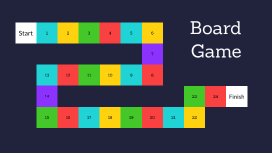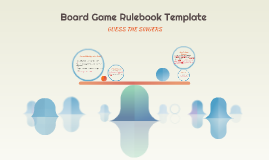Creating a Board Game Template
Transcript: Creating a Board Game Template Introduction to Board Games Definition of Board Games Board games are defined as interactive games played on a flat surface, utilizing a specific set of rules to facilitate competition or cooperation among players. They can vary widely in theme and complexity, catering to diverse audiences. History of Board Games The history of board games dates back to ancient civilizations. Games like Senet from Egypt and Go from China illustrate the cultural significance and evolution of gaming as a form of social interaction throughout human history. Importance of Board Games Board games play a crucial role in developing critical thinking and social skills. They encourage strategic thinking, enhance problem-solving abilities, and foster interpersonal connections among players, making them valuable educational tools. A Step-by-Step Guide to Designing Your Own Game Components of Board Games Pieces and Tokens Game Board The game board is the primary surface on which the game is played. It may feature unique designs, paths, or zones that represent different elements of gameplay and strategy. The board layout significantly affects player interactions and game flow. Game pieces and tokens are vital for player representation on the board. They can vary in shape, size, and material, and are used to signify player positions, resources, or game actions. The design of these pieces can enhance thematic immersion. Rules and Instructions Cards and Dice Rules and instructions guide the flow of the game and inform players how to play effectively. Clear and concise rules ensure players understand objectives, actions, and victory conditions, which is essential for an enjoyable experience. Cards and dice introduce randomness and strategy into games. Cards can provide actions, events, or information, while dice are often used to determine outcomes and movements. The inclusion of these components adds layers of gameplay depth. Designing Your Board Game Concept and Theme The concept is the core idea behind the board game, encompassing the theme, narrative, and tone. A strong theme, such as fantasy or strategy, can captivate players and enhance their experience. Mechanics and Gameplay Target Audience Identifying the target audience is crucial for tailoring the game experience. Consider age groups, interests, and gaming experience to ensure the game appeals to potential players. Game mechanics define how players interact with the game, including rules, objectives, and methods of play. Innovating mechanics can lead to a dynamic gameplay experience, which impacts player engagement. Playtesting and Feedback Prototyping Your Game Creating a prototype allows designers to visualize the game and test mechanics practically. Prototypes can be simple or detailed, and are vital in refining gameplay through feedback and iterations. Finalizing the Game Importance of Playtesting Iterating on Design Gathering Feedback Finalizing the game means ensuring all components function seamlessly together. Playtesting should continue until the designer is confident that the game is polished, balanced, and ready for production or publication. Collecting feedback can be done through surveys, interviews, or casual discussions post-game session. Targeted questions about mechanics, enjoyment, and clarity will yield specific insights that can guide revisions. Playtesting allows designers to observe real players interacting with the game, revealing unforeseen issues. It helps identify both gameplay enjoyment levels and any confusing elements that may need adjustments, ensuring the game is player-friendly and enjoyable. Iteration involves using the feedback to make meaningful changes to the game. It's essential to review all suggestions objectively, considering their impact on gameplay and how they align with the game's core mechanics.

















